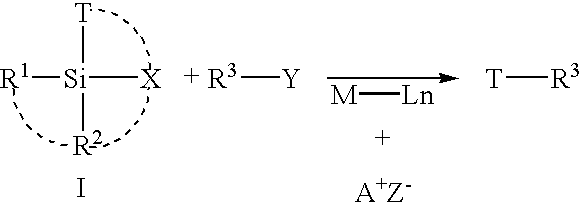Cross-coupling reaction of organosilicon nucleophiles
a cross-coupling reaction and organosilicon technology, applied in the direction of hydrocarbon preparation catalysts, hydrocarbons, group 4/14 element organic compounds, etc., can solve the problem of reducing the formation of undesired side-products, and achieve high product yield, high stereospecificity, and easy preparation
- Summary
- Abstract
- Description
- Claims
- Application Information
AI Technical Summary
Benefits of technology
Problems solved by technology
Method used
Image
Examples
example 1
General Experimental
Analytical thin-layer chromatography was performed on Merck silica gel pates with QF-254 indicator Visualization was accomplished with UV light and / or potassium permanganate. Methanol was of reagent grade and used as received; other solvents for chromatography and filtration were technical grade and distilled from the indicated drying agents: hexane and pentane (CaCl2) ethyl acetate (K2CO3). Column chromatography was performed using Science 230-400 mesh silica gel or ICN silica RP C18 (32-63 μm) 60A.
Analytical capillary gas chromatography (GC) was performed using a Hewlett Packard 5890 Series II gas chromatograph fitted with a flame ionization detector (H2 carrier gas, 1 mL / min) and an HP-5 (50-m, 0.2 mm) cross-linked phenyl methyl silicone capillary column. The injector temperature was 225° C., the detector temperature was 300° C. Oven temperature and head pressures specified. Retention times (tR) and integrated ratios were obtained from Hewlett Packard 3393A in...
example 2
1-Chloro-1-(4′-methoxyphenyl)silacyclobutane B
4-Methoxyphenylmagnesium bromide solution in Et2O was prepared in conventional method and titrated.2 To a solution of A (5.61 g, 39.7 mmol, 1.2 equiv) in Et2O (80 mL) was added 4-methoxyphenylmagnesium bromide (24.0 mL, 1.38 M, 33.1 mmol) dropwise over 1 h at 0° C. Then the reaction mixture was allowed to warm up to room temperature and was stirred overnight. After Schlenk filtration, all the solvent was removed by simple distillation and the residue was purified by fractional distillation under vacuum to afford 5.21 g (73%) ofB as a colorless oil.
1-Fluoro-1-(4′-methoxyphenyl)silacyclobutane C
To a solution of B (2.98 g 14.0 mmol) in Et2O (60 mL) was added CuF2 (0.71 g, 7.0 mmol, 0.5 equiv) at 0° C. The reaction mixture was allowed to warm up to room temperature and was stirred overnight. The solid was removed by quick filtration through celite and the solvent was distilled off by simple distillation. The residue was then purified by frac...
example 3
Preparation of (E)-Dimethyl-(1-heptenyl)silanol (E)-50
To a solution of (E)-1-bromo-1-heptene (5.313 g, 30.0 mmol) in dry ether (30 mL) under dry N2 at −78° C., t-butyllithium (38.7 mL, 60 mmol, 1.55M) was added over 10 min. The reaction mixture was stirred at −78° C. for 1 h. The hexamethylcyclotrisiloxane (2.225 g, 10.0 mmol) in dry ether (30 mL) was then added over 5 min at −78° C. The reaction was warmed to room temperature and stirred for 24 h. The solution was then cooled to 0° C. and quenched with water (30 mL). The aqueous phase was extracted with ether (3×10 mL) and the combined organic phases were washed with water (1×10 mL) and brine (3×30 mL). The organic layer was dried with magnesium sulfate (anhydrous) and filtered. The solvent was then evaporated in vacuo to give a yellow oil which was purified by distillation to afford 3.836 g (74%) of (E)-50 (3.836 g, 74%) as a colorless oil.
Preparation of (Z)-Dimethyl-(1-heptenyl)silanol (Z)-50
To a solution of (Z)-1-iodo-1-heptene ...
PUM
| Property | Measurement | Unit |
|---|---|---|
| polar aprotic | aaaaa | aaaaa |
| temperature | aaaaa | aaaaa |
| compatibility | aaaaa | aaaaa |
Abstract
Description
Claims
Application Information
 Login to View More
Login to View More - R&D
- Intellectual Property
- Life Sciences
- Materials
- Tech Scout
- Unparalleled Data Quality
- Higher Quality Content
- 60% Fewer Hallucinations
Browse by: Latest US Patents, China's latest patents, Technical Efficacy Thesaurus, Application Domain, Technology Topic, Popular Technical Reports.
© 2025 PatSnap. All rights reserved.Legal|Privacy policy|Modern Slavery Act Transparency Statement|Sitemap|About US| Contact US: help@patsnap.com



